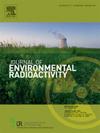Modelling soil – Vegetation – Atmospheric interactions of radon products in a Belgian Scots pine forest site
IF 1.9
3区 环境科学与生态学
Q3 ENVIRONMENTAL SCIENCES
引用次数: 0
Abstract
A soil-vegetation-atmospheric transfer (SVAT) model for radon and its progeny is presented to improve process-level understanding of the role of forests in taking-up radionuclides from soil radon outgassing. A dynamic system of differential equations couples soil, tree (Scots pine) and atmospheric processes, treating the trees as sources, sinks and conduits between the atmosphere and the soil. The model's compartments include a dual-layer soil column undergoing hydrological and solute transport, the tree system (comprising roots, wood, litter, and foliage) and the atmosphere, with physical processes governing the transfers of water and radon products between these compartments. A dose post-processor calculates dose rates to the trees from internal, external, and surface radiation exposures. The model parameterisation is based on measurement data from the Grote Nete Valley in the Belgian Campine region.
The model results suggest that the tree intake of radon progeny is principally from the atmosphere, whereas radium is mainly taken-up from soil by the root uptake process, leading to an additional fraction of ingrown radon progeny in the tree by this route. It is also suggested that atmospheric uptake of radon is an essential mechanism when evaluating the tree uptake of 214Po, 214Pb and 218Po and subsequent decay products. The model also indicates a slow uptake of radionuclides by the tree roots, with timescales in the order of years, leading to different dose rates for young and mature trees. The importance of foliar surface deposition, leading to a dominance of surface doses to the tree needles, is also highlighted. These mechanisms, ignored in most assessment models, are necessary improvements for assessment tools dealing with the impact of radon and its progeny in forests, with regard to legacy sites with 226Ra contamination.
模拟土壤-植被-氡产物在比利时苏格兰松林地点的大气相互作用。
提出了氡及其子代的土壤-植被-大气转移(SVAT)模型,以提高对森林从土壤氡排放中吸收放射性核素的作用的过程水平的认识。一个动态的微分方程系统将土壤、树木(苏格兰松)和大气过程耦合在一起,将树木视为大气和土壤之间的源、汇和管道。该模型的隔室包括经历水文和溶质运输的双层土壤柱、树木系统(包括根、木材、凋落物和树叶)和大气,以及控制这些隔室之间水和氡产品转移的物理过程。剂量后处理程序计算内部、外部和表面辐射照射对树木的剂量率。模型参数化是基于来自比利时Campine地区Grote Nete山谷的测量数据。模型结果表明,树木对氡子代的吸收主要来自大气,而镭主要通过根系吸收过程从土壤中吸收,导致树木通过这一途径向内生长的氡子代的额外部分。大气对氡的吸收是评价树木对214Po、214Pb和218Po及其衰变产物吸收的重要机制。该模型还表明,树根对放射性核素的吸收缓慢,时间尺度以年为单位,导致幼树和成熟树的剂量率不同。叶面沉积的重要性,导致表面剂量对针叶的优势,也被强调。这些机制在大多数评估模型中被忽视,但对于处理氡及其子代在森林中对226Ra污染遗留地点的影响的评估工具来说,是必要的改进。
本文章由计算机程序翻译,如有差异,请以英文原文为准。
求助全文
约1分钟内获得全文
求助全文
来源期刊

Journal of environmental radioactivity
环境科学-环境科学
CiteScore
4.70
自引率
13.00%
发文量
209
审稿时长
73 days
期刊介绍:
The Journal of Environmental Radioactivity provides a coherent international forum for publication of original research or review papers on any aspect of the occurrence of radioactivity in natural systems.
Relevant subject areas range from applications of environmental radionuclides as mechanistic or timescale tracers of natural processes to assessments of the radioecological or radiological effects of ambient radioactivity. Papers deal with naturally occurring nuclides or with those created and released by man through nuclear weapons manufacture and testing, energy production, fuel-cycle technology, etc. Reports on radioactivity in the oceans, sediments, rivers, lakes, groundwaters, soils, atmosphere and all divisions of the biosphere are welcomed, but these should not simply be of a monitoring nature unless the data are particularly innovative.
 求助内容:
求助内容: 应助结果提醒方式:
应助结果提醒方式:


